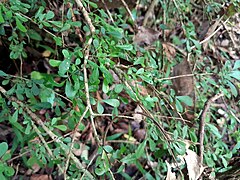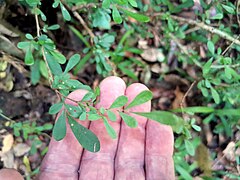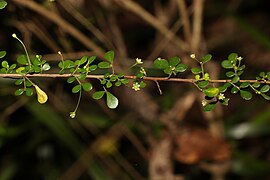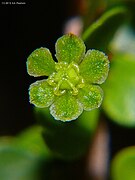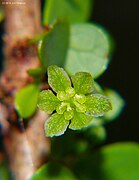Phyllanthus microcladus
| Phyllanthus microcladus | |
|---|---|

| |
| Brush sauropus | |
| Scientific classification | |
| Kingdom: | Plantae |
| Clade: | Tracheophytes |
| Clade: | Angiosperms |
| Clade: | Eudicots |
| Clade: | Rosids |
| Order: | Malpighiales |
| Family: | Phyllanthaceae |
| Genus: | Phyllanthus |
| Species: | P. microcladus
|
| Binomial name | |
| Phyllanthus microcladus | |
| Synonyms | |
Phyllanthus microcladus, commonly known as the brush sauropus or small-leaved Phyllanthus, is a plant in the family Phyllanthaceae found in tropical and sub tropical areas of eastern Queensland and northeastern New South Wales in Australia.[4][5] It is listed as endangered in New South Wales, but in Queensland it is assessed as least concern.[1][5][6] It occurs by streams in rainforest, from near Grafton northwards to around Cairns.
Description
[edit]The brush sauropus is a small evergreen shrub which reaches a height of 35 cm (14 in) in the southern parts of its range,[5] but may grow to 2 m (6 ft 7 in) in the north.[4] The leaves are simple and opposite, and clustered on short branchlets. They usually measure between 2 and 9 mm (0.08 and 0.35 in) long and are somewhat egg-shaped with the narrower end attached to the twig on a petiole about 1 mm (0.04 in) long.[4][5][6]
The inflorescences are produced in the leaf axils, and may consist of a single flower or a small cluster. The flowers are either male or female and in most cases both sexes occur on the one plant. They are about 4 mm (0.16 in) diameter, the male flowers held on a fine stem up to 10 mm (0.39 in) long and the female ones on a stem up to 20 mm (0.79 in) long. The fruit is a smooth round capsule about 3 mm (0.12 in) diameter.[4][5]
Taxonomy
[edit]This species was first described in 1865 by the Swiss botanist Johann Müller, who published his works under the name Johannes Müller Argoviensis to distinguish himself from other botanists of the time with similar names. He described two varieties – Phyllanthus microcladus var. microphyllus which was based on material collected from the Clarence River in New South Wales, and Phyllanthus microcladus var. puberulus based on material collected at Moreton Bay in Queensland.[7] Both varieties are now considered to be synonyms of the parent.[3]
Müller's paper was published in the German-language journal Linnaea: ein Journal für die Botanik in ihrem ganzen Umfange, oder Beiträge zur Pflanzenkunde.[2][7]
Distribution and habitat
[edit]Phyllanthus microcladus is found in scattered populations from near Mossman in northeast Queensland to the Northern Rivers region of New South Wales. The preferred habitat is alongside creeks and rivers in tropical and subtropical rainforest.[4][5]
In New South Wales much of the former habitat areas have been cleared for agriculture and housing. Populations are small and fragmented, and they are threatened by invasive weeds and by being crushed by domestic animals such as cattle. Stream erosion also threatens their habitat.[6]
Conservation
[edit]This species is listed by the Queensland Government's Department of Environment, Science and Innovation as least concern.[1] As of 9 February 2024[update], it has not been assessed by the International Union for Conservation of Nature (IUCN).
Gallery
[edit]-
Habit
-
Foliage
-
Foliage and flowers
-
Female flower
-
Male flower
-
Fruit
References
[edit]- ^ a b c "Species profile—Phyllanthus microcladus". Queensland Department of Environment and Science. Queensland Government. 2022. Retrieved 20 July 2023.
- ^ a b "Phyllanthus microcladus". Australian Plant Name Index (APNI). Centre for Australian National Biodiversity Research, Australian Government. Retrieved 20 July 2023.
- ^ a b "Phyllanthus microcladus Müll.Arg". Plants of the World Online. Royal Botanic Gardens, Kew. Retrieved 20 July 2023.
- ^ a b c d e F.A.Zich; B.P.M.Hyland; T.Whiffen; R.A.Kerrigan (2020). "Phyllanthus microcladus". Australian Tropical Rainforest Plants Edition 8 (RFK8). Centre for Australian National Biodiversity Research (CANBR), Australian Government. Retrieved 20 July 2023.
- ^ a b c d e f "PlantNET - FloraOnline". PlantNET (The NSW Plant Information Network System). Royal Botanic Gardens and Domain Trust, Sydney. Retrieved 21 July 2023.
- ^ a b c "Brush Sauropus - profile". NSW threatened species. Government of New South Wales. 2005. Archived from the original on 29 February 2012. Retrieved 20 July 2023.
- ^ a b Johann Müller (1865). "Euphorbiaceae: Vorläufige mittheilungen aus dem für DeCandolle's Prodromus bestimmten Manuscript über diese Familie". Linnaea. 34: 71–72. Retrieved 21 July 2023.
External links
[edit] Data related to Phyllanthus microcladus at Wikispecies
Data related to Phyllanthus microcladus at Wikispecies Media related to Phyllanthus microcladus at Wikimedia Commons
Media related to Phyllanthus microcladus at Wikimedia Commons- View a map of historical sightings of this species at the Australasian Virtual Herbarium
- View observations of this species on iNaturalist
- View images of this species on Flickriver

